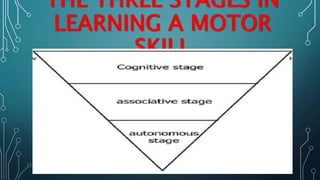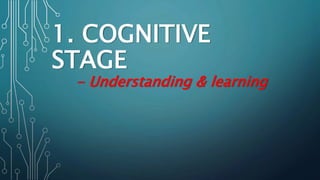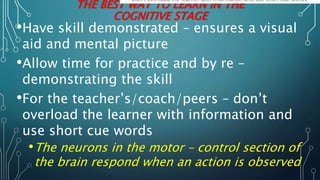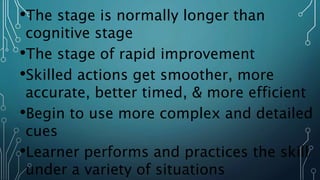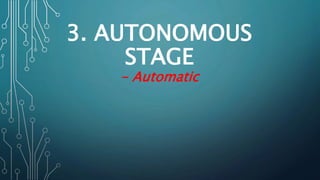The process of learning motor skills
- 1. THE PROCESS OF LEARNING MOTOR SKILLS THEORY BY: PAUL M.FITSS AND MICHAEL I. POSNER 1967
- 3. ŌĆóThis theory continues to be referred to by sports researchers until today ŌĆóIt proposes that everyone goes through distinct stages when learning a motor skill
- 4. THE THREE STAGES IN LEARNING A MOTOR SKILL
- 10. 1. COGNITIVE STAGE - Understanding & learning
- 11. ŌĆóYou learn what is needed to perform a skill. ŌĆóFrequent errors occur ŌĆóAttention to decisions & step ŌĆō by ŌĆō step procedures ŌĆóHave a high attentional demands (lots of Thinking) ŌĆóTend to perform the skill slowly ŌĆóREQUIRES A LOT OF FEEDBACK (teacher,
- 12. THE BEST WAY TO LEARN IN THE COGNITIVE STAGE ŌĆóHave skill demonstrated ŌĆō ensures a visual aid and mental picture ŌĆóAllow time for practice and by re ŌĆō demonstrating the skill ŌĆóFor the teacherŌĆÖs/coach/peers ŌĆō donŌĆÖt overload the learner with information and use short cue words ŌĆóThe neurons in the motor ŌĆō control section of the brain respond when an action is observed
- 13. STEP CYCLE
- 15. ŌĆóRefine the accuracy and consistency of the motor skill ŌĆóThere is a reduce numbers of errors ŌĆóPerformer gradually gets more successful & fluent ŌĆóLearner begins to make use of intrinsic or kinesthetic feedback ŌĆóBegin to pay attention to the concurrent feedback (During
- 16. ŌĆóThe stage is normally longer than cognitive stage ŌĆóThe stage of rapid improvement ŌĆóSkilled actions get smoother, more accurate, better timed, & more efficient ŌĆóBegin to use more complex and detailed cues ŌĆóLearner performs and practices the skill under a variety of situations
- 20. ŌĆóSome performers may only reach the autonomous stage after many years of practice, others may not reach this stage ŌĆóSequencing ad timing of the subroutines is automatic; less conscious attention ŌĆóProcess larger chunks of information that occurs without attention ŌĆóPerformer analyzing own performance and adjust own actions ŌĆóHigh level of smoothness, efficacy, accuracy is performed without stress
- 22. OVERVIEW




